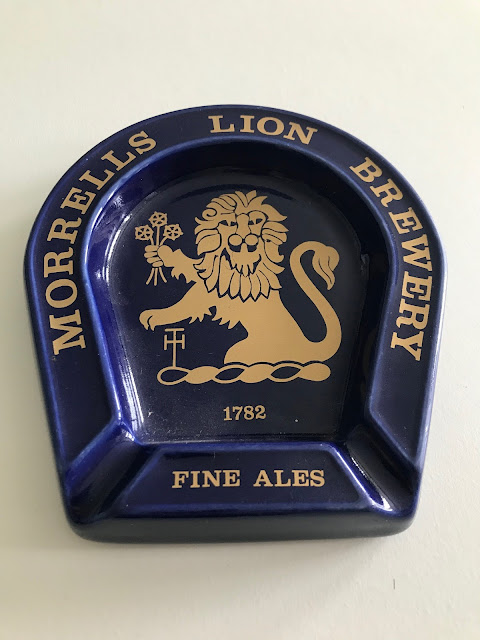Morrells Brewery, also known as the Lion Brewery were founded by Richard Tawney in 1743. In 1797 a partnership was formed with local lawyers, Mark and James Morrell who soon became the outright owners. The brewery was developed over the years although at one time it was powered by a traditional waterwheel supplemented by steam engines - one of the latter is still preserved at the Abbey Pumping Station in Leicester. In the late 20th century the brewery was more heavily invested with a duel purpose brewery installed with a capacity of 50,000 barrels of ale and 25,000 barrels of lager, the latter primarily to brew Harp lager. A separate warehouse facility was also purchased in 1990 to allow the brewery more space to prosper.
The Morrells became a well to do family in Oxford and lived in Headington Hill Hall, a prestigious property they had built on the edge of Oxford (later to be leased by Oxford City Council to Robert Maxwell who described it as the best council house in the country!). Successive generations of the Morrells family prospered around Oxford including George Herbert Morrell who became High Sheriff of Oxfordshire, Lady Ottoline Morrell, a well known English aristocrat and society hostess and her husband Philip Morrell, a Liberal MP in the early 20th century.
 |
| Morrells Brewery entrance |
In 1938, Emily's son, yet another James, supervised the winding up of the Trusts and reformation of the business as a limited company where he became MD and Chairman. Over the next 50 years Morrells changed hugely to survive the rapid changes going on the brewing industry. James eventually passed away in 1965 and by the time of its closure in 1998 the company was being run by 8th generation family member Charles Eld, grandson of James.
So this brings us to the brewery's demise. Certainly it was true of the late 1980's and 1990's that although the brewery had seen investment, their pubs were the opposite and considered under-invested. Many were small local pubs and whereas other brewers had tried to move with the market and invest in new pub retail sites offering family food etc, Morrells had not done likewise. As a result their pubs were seen as run down and not always in the best areas. From my personal opinion living in Oxfordshire at that time, I'd certainly say they where seen as the poor relation against the likes of Morland and Brakespear.
Another factor were the beer brands. They had some good beers in Oxford Bitter, Varsity and Graduate, but had failed to invest in the marketing of them. As a result they were not best placed for the opportunity created by the 1988 Beer Orders Monopolies and Mergers report which freed up the market place for guest beers. Other brewers were faster on their feet and Morrells missed their chance here.
It can also be argued they backed the wrong horse with Harp Lager. Other standard lagers such as Heineken, Carling and ultimately Fosters became stronger brands and Morrells tied pubs were limited by having to offer Harp as their mainline standard lager. Harp was a brand that spearheaded the UK's lager drinking revolution of the 1960's along with Skol but by the 1990's it was in decline and even a relaunch with a stronger abv failed to ignite sales.
So onto the story of family dispute. Morrells found themselves in a situation where they had a relatively modern brewing facility, but not brewing near to capacity. They did not have strong ale brands, these selling mainly to their pubs with limited freetrade demand. Furthermore they had virtually no take home presence for the beers as they had closed their bottling line. Harp, the contracted lager was also in decline affecting both their freetrade and pub business. The pub estate was run down and although they had some potentially good sites, these had not seen any investment and there were missed opportunities to buy new ones.
So it should not really come as a surprise when in 1998 after a terse Boardroom battle MD Charles Eld was escorted from the building after being sacked from his job. It followed what appears to have been a major disagreement with other family members about the future direction of the company. Eld had fought to keep the company independent and maintain brewing in Oxford, but the company was in urgent need of investment and that ultimately led to its sale and Eld's sacking.
 |
| Charles Eld seen behind the bar in Far from the Madding Crowd |
There were 19 bidders for the Morrells business when it came up for sale. I recall Morland Brewery who I worked for at the time was one of them and they got down to a final shortlist of three. None of the bidders proposed maintaining the brewery in Oxford as this was a prime redevelopment opportunity. Morrells was eventually purchased by Michael Cannon for £48m, the brewery was officially closed in May 2000 and its beers were contracted out to Eldridge Pope. Cannon would eventually sell the majority of the Morrells pub estate onto Greene King in 2002.
A postscript for Charles Eld is that in 2002 he opened his own pub in Oxford called Far from the Madding Crowd. Elds passion for real ale shone through and the pub was awarded the Oxford CAMRA Real Ale Pub of year for three years.
So in the space of five years the Morrells brewery and pubs were gone, the end of a dynasty that began in 1743. How sad that it happened but the late 20th century saw huge changes in the beer and pub industry with a number of long standing family brewers being sold, taken-over and closed. I will always remember Morrells fondly for although I did not much like their beers, many of my early drinking memories are in and around some of their pubs.
 |
| Morrells Brewery Ashtray |




